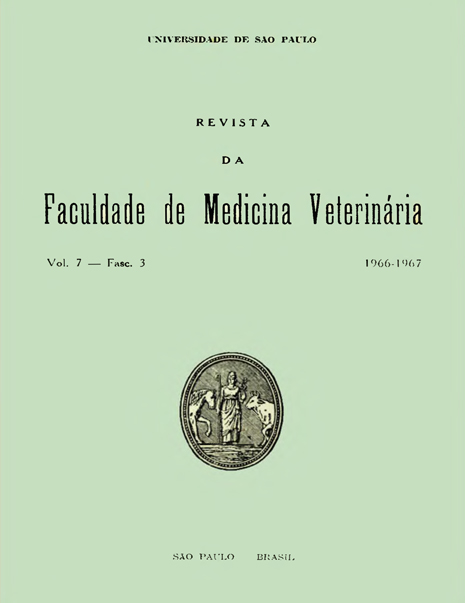Survey on the mineral elements in forages plants produced in limited areas of São Paulo State, Brazil. I — Calcium, phosphorus and magnesium
DOI:
https://doi.org/10.11606/issn.2318-5066.v7i3p583-604Keywords:
The article has no keywords.Abstract
In this paper, it was carried out a survey on calcium, phosphorus and magnesium contents in three of the most common grasses — Colonião (Panicum maximum), Jaraguá (Hyparrhenia rufa (Nees) Stapf) and Gordura (Melinis minutiflora), collected in limited areas at the hinterland of São Paulo (Brazil). The samples were collected according with the different types of soils and during the dry and wet seasons. The results obtained can be summarized:
a) Calcium
The Jaraguá grass that showed the highest calcium value —0,45% — in dry season, differed significantly, only in relation with the Gordura that showed the lowest calcium content — 0,27%— in the wet season. However, in the wet season, the calcium of the three studied grasses, showed an uniform and significantly low contents in relation with the ones verified in the dry season (tables II, V and fig.II).
b) Phosphorus
The distribution of this element in the grasses was not similar as there was significantly difference between the Colonião (Panicum maximum) and Jaraguá (Hyparrhenia rufa) (Nees) Stapf), but not between the former and the Gordura (Melinis minutiflora). Significant differences were verified between seasons — highest values in the wet season — and interactions as well (tables III, V and fig. III). In the dry season, the phosphorus contents showed the lowest values in the three forage plants. But, during the wet season, these values came up in order to reach rapidly the normal values.
c) Magnesium
The highest value obtained for the magnesium concentration in the Jaraguá grass whose levels — 0,36% and 0,26% —, in the dry and wet seasons, respectively — differed significantly only in relation to the Gordura grass. The highest levels of the magnesium were obtained in the dry season in the same way we have seen in relation with the calcium but different in connection with the phophorus (tables IV,V and fig. IV). Analyzing the results contained in the present report, it seems that the calcium and magnesium levels in the collected grasses in this limited area were in optimum concentration for the nutritive requirement of the animals maintained in herbage pasture where a minimum of calcium — 0,15% to 0,20% — and magnesium— 0,2% — is provided. However, the phosphorus deficiency levels found in these forage plants, in dry season, ratified previous papers that phosphorus and salt supplements should be supplied.


